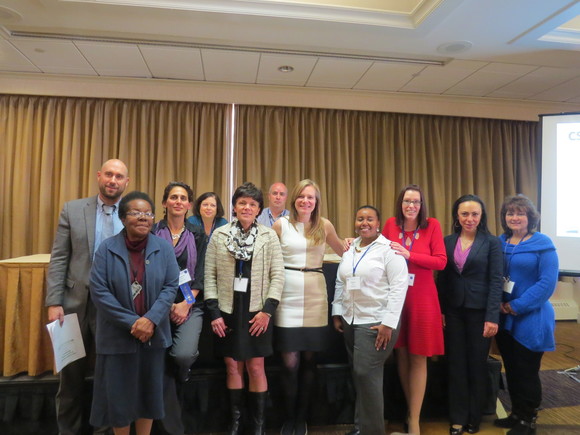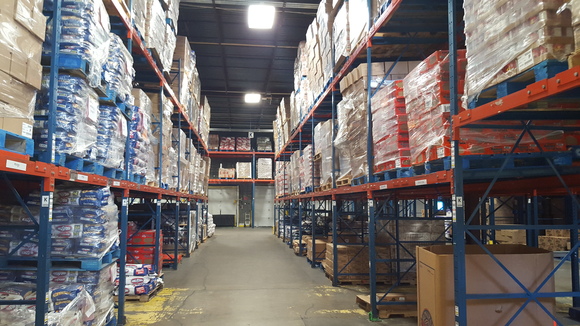|
USDA is providing nutrition education ‘test tube’ sets for Commodity Supplemental Food Program (CSFP) local agencies that have an agreement with a State agency to operate the program. Sets of ten ‘test tubes’ are filled to show the amount of fat, sugar, or salt in common foods. Some of the foods depicted have reasonable amounts of fat, sugar, and salt, and others have excessive amounts. Each kit is accompanied by suggestions for using the 'test tubes' to provide a quick visual lesson.
Shipments of the items began during the week of December 7 and continued through the week of December 14. Each local agency received four sets including ‘How Much Fat?’ Parts 1 and 2, ‘How Much Salt?’ and ‘How Much Sugar?’ Packages included a memorandum from Laura Castro, Food Distribution Division (FDD) Director, with tips for using the products and contact information for obtaining more information regarding the kits.
Nutrition Education test tubes
 USDA Food and Nutrition Service (FNS) hosted the “Demystifying the USDA Foods Complaint
Process” webinar on December 11. This first installment of a two-part series focused on what to
expect from the complaint process. Complaint team members Andre Orange and Tony Wilkins provided guidance on who, what, where, when, and how to file a complaint and what actions to expect from USDA in response.
The second complaints webinar, “Applying
the USDA Foods Complaint Process,” is scheduled for January 7 at 2:00
p.m. EST. Register here, and if you missed the first webinar, you can view the recording here!
|
The
USDA Food and Nutrition Service’s Northeast and Mid-Atlantic Regional Offices
joined together for a bi-regional CSFP Conference on December 2-4 in
Alexandria, VA. This conference brought together more seasoned states with less
experienced states to discuss program requirements, share best practices, and
foster a bi-regional network of federal, state, and local agencies. Staff from
FNS headquarters also participated in this USDA team effort to assist our new
CSFP states in building successful programs.
 Representatives from the USDA Northeast Regional Office, Mid-Atlantic Regional Office, and National Office presented at the Bi-Regional NERO/MARO CSFP Conference in Alexandria, VA in December.
Fiscal Year (FY) 2016 bonus offerings to The Emergency Food Assistance Program (TEFAP) have commenced. On November 4, the Agricultural Marketing Service (AMS) and FNS offered $20 million (an estimated 96 truckloads) of catfish fillets to TEFAP as bonus. Bonus offerings result from the surplus removal program, which allows USDA to purchase foods in order to help stabilize prices in agricultural commodity markets by balancing supply and demand, while providing healthy foods to low-income households.
Many people enjoy the flavor of catfish, but it offers a variety of health benefits as well. Including this nutritious fish in your diet helps to meet your protein needs and boosts intake of vitamins and healthy fats and fatty acids.

|
Kosher Peanut Butter and Kosher Halal Certified Tomato Sauce have been added to the Foods Available List for TEFAP 2016. Section 4207 of the Agricultural Act of 2014 (P.L. 113-79) required USDA to finalize and implement a plan to increase the purchase of Kosher and Halal foods from certified manufacturers. Kosher Pink Salmon was added to the TEFAP Foods Available List with successful purchases in 2014 and 2015. USDA has purchased Kosher Peanut Butter and Kosher Halal Certified Tomato Sauce for January through March 2016 deliveries, and orders can be placed in the Web-Based Supply Chain Management system for April through December 2016 delivery timeframes. Nearly 90 nutritious, high quality products are available for TEFAP ordering in 2016.
|

On November 5, USDA staff visited the headquarters of Pinnacle Foods Incorporated in Parsippany, New Jersey, to meet with Pinnacle’s leadership staff. The company is one of the vendors that supplies canned meat and stew items offered to CSFP, TEFAP, and the Food Distribution Program on Indian Reservations (FDPIR). Pinnacle’s commercial brands include, among others, Nalley® canned beef stew and chili products, Birds Eye® frozen vegetables, and Van de Kamp® fish products. The company provided an overview of sales and marketing strategies along with research and development and quality assurance initiatives. A nutritionist from the Food and Nutrition Service provided an overview of household USDA Foods programs including the populations served by USDA’s federal nutrition assistance programs, the role of nutritionists who work on these programs, and the nutrition standards used for selecting foods that are offered to participants of CSFP, TEFAP, and FDPIR. Agricultural Marketing Service staff led the discussion regarding product solicitations and procurement practices, item descriptions for foods solicited, and product specifications for USDA Foods.
The successful, informative, and productive meeting also included product samplings of canned beef stew and canned chili with different levels of sodium, conducted by the company’s food technologist, and tastings coordinated by the company’s chef that included several of the company’s federal and commercial products.
|
A group of university students
created an innovative resource to help connect food donors with pantries in
their area. This online resource is called the Matching Excess and
Need Database, or MEANS Database, and it is a site that ensures food donations
find their way to programs that can use them. Participation is free. Users must register to
post or accept donations and there is an option to receive email alerts based
on item location and product type. This site is currently active in 27
states with 662 food banks, food pantries, and emergency feeding locations
registered. For more information, check out the website. Please
note, this is not a USDA database. The USDA does not endorse any external
public products or services. Thank you.
 Hunger Solutions Minnesota is excited to announce
the recipients of the first round of Mobile Food Shelf funding. The $1
million in competitive grants will go to 17 TEFAP food shelf programs to start or
expand their mobile food shelf programs. Mobile food shelves bring food
to individuals and communities unable to access traditional food
shelves because of disability, age, or distance. The $1 million funding is from an appropriation passed by the
Minnesota Legislature in 2015. An additional round of funding will be issued in
2016. Learn more about Mobile Food Shelf grants.
|
Second Harvest Heartland Food Bank in St. Paul, Minnesota, partners with food pantries, soup kitchens, shelters, and after-school programs to distribute food to those in need through TEFAP. The food bank also procures food from manufactures, farmers, and food drives to distribute over 74 million meals annually. With this amount of food coming in and out of its doors, it is imperative that proper inventory control procedures are in place and are utilized throughout the facility. David Laskey, Director of Food Bank Operations, has developed a procedure manual to adequately organize and maintain the abundance of food that is collected and distributed. If you would like to receive a PDF of Second Harvest Heartland's inventory control procedures, please send your request to USDAFoods@fns.usda.gov.
 Second Harvest Heartland Food Bank distribution site in St. Paul, Minnesota
We often get questions on food storage requirements for USDA
Foods, especially for the cheese offered in CSFP. The USDA Foods fact sheets, available online, include information on storage requirements
for all of our food items. In the case of
cheese, this product must be refrigerated. This means that it
needs to be stored in the range of 36 - 40
degrees. The FDPIR Handbook, FNS 501,
provides excellent guidance on temperatures for USDA Foods. Although
intended for FDPIR, the temperature ranges for dry, refrigerated, and frozen
storage areas can be applied to any warehouse storing USDA Foods.
Policy Memo FD-107: Storage and Inventory Management of USDA
Donated Foods
includes guidance related to First-In First-Out (FIFO) in relation to
best-if-used-by dates and provides that State and local agencies must consider
best-if-used-by dates in managing their USDA foods inventories and distribute
USDA foods in a manner that allows them to be consumed by such date. Finally, program regulations at 7 CFR 250.14 provide additional information on
food storage requirements for USDA Foods.

On December 31, 2015, FNS issued 2016 caseload and
administrative funding for CSFP States, based on an FY 2016
funding level of $222.198 million. This amount includes limited additional
funding to begin CSFP in Virginia, the only State with an approved State plan
but not currently participating. Based on this full-year funding level,
FNS issued a final national caseload allocation of 619,000 caseload slots for
the 2016 caseload cycle (January 1, 2016 to December 31, 2016). This is a
15,000 slot increase from the 2015 national caseload level of 604,000.
With the addition of Virginia to CSFP, the program is now being operated by
forty-seven States, two Indian Tribal Organizations, and the District of
Columbia.
CSFP is a discretionary
program with limited resources; over- or under-usage of caseload affects the
availability of current and future program resources nationwide. It is in the
best interest of each State to manage its caseload effectively.
Some examples of caseload management strategies include
waitlist management and no-show policies. State agencies are required to
maintain waiting lists if all caseload slots are filled. To streamline
the waiting list process, State agencies may permit certification for
applicants before they are placed on the waitlist. This can save time
when a new caseload slot opens up, since the applicant has been
pre-certified.
State agencies can allow for no-show policies for more
effective caseload management. In some States, after a participant misses two
or three consecutive distributions, that individual is discontinued from the
program (with at least 15 days’ written notice). The waiting list can then be
used to fill that caseload slot. Some State agencies allow for one-month
certifications to distribute food packages that are not picked up due to
no-shows, to fully utilize state caseload slots each and every month.
For further information on caseload management, please refer
to Policy Memo FD-099: Questions and Answers about Caseload Management
and program regulations at 7 CFR Part 247.
The most recent release for the Web-Based Supply Chain Management system (WBSCM) includes an update to entitlement management for TEFAP. At the beginning of December, release 3.7.0 added a “Previous Year Carry Over” field to the TEFAP entitlement budgeting screen. This allows State Distributing Agencies (SDAs) to roll down the “Previous Year Carry Over” information received from FNS to Recipient Agencies (RAs). Updated work instructions for maintaining and uploading RA entitlements can be found in WBSCM under Help --> Training --> Work Instructions --> External --> Fulfillment.
To support the changes in WBSCM, the RA entitlement upload file template for TEFAP was also modified. SDAs can now include “Previous Year Carry Over” values for all RAs with their upload. This template is available on the FNS website.
If you have questions about uploading or maintaining TEFAP entitlements in WBSCM, please contact the WBSCM help desk at 877-WBSCM-4U (877-927-2648) or by email to WBSCMhelp@ams.usda.gov.


Food Distribution staff will be participating in these upcoming national meetings in 2016. We look forward to these opportunities to meet you and hope to see you there!
February 28-March 1: Feeding America/Food Research and Action Center (FRAC)
National Anti-Hunger
Policy Conference in Washington, DC
May 9-11: American Commodity Distribution Association (ACDA) Annual Conference in St. Pete Beach, Florida
 Here's how to sign up for these updates via GovDelivery:
1. Go to the Food Distribution website.
2. Click on the red envelope on the row of social media icons on the top right of the page.
3. Enter your email address and click "Submit."
4. Check the boxes to select your topics of interest. For these e-letters, scroll down to the Food Distribution category and click the plus sign to the left of the check box to expand the list and view all the sub-categories. Check these sub-categories to receive the corresponding e-letters:
*USDA Foods --> receive all "USDA Foods from Farm to Plate" general + program-specific e-letters
*Commodity Supplemental Food Program (CSFP) --> receive "Household Highlights" e-letter
*The Emergency Food Assistance Program (TEFAP) --> receive "Household Highlights" e-letter
*Food Distribution Program on Indian Reservations (FDPIR) --> receive "FDPIR Connection" e-letter
*Schools/Child Nutrition Commodity Programs --> receive "Spotlight on Schools" e-letter
5. Update your subscription preferences any time by following the above steps or clicking on the Subscriber Preferences Page link at the bottom of any of the e-letter email messages you receive from GovDelivery. Questions? Contact us at USDAFoods@fns.usda.gov
|
|